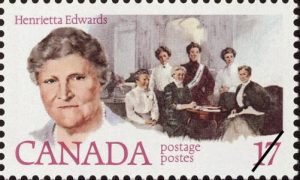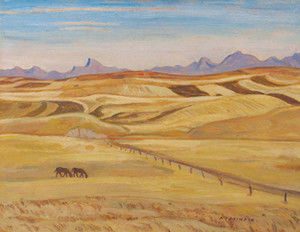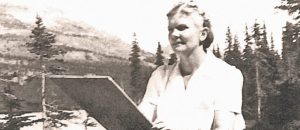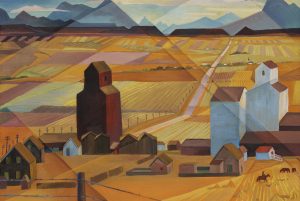(March 8, 2017) In several previous posts about international women’s day the important role played by prairie grain farmers and their organizations in advancing the equality of women in Canada has been highlighted. From the 1890s the Territorial Grain Growers Association adopted a policy that women would be full and equal voting members and the web of support developed from there.
How wide that web spread was brought home to me this weekend when I attended a lecture by one of Canada’s foremost art historians and a former curator at the Glenbow, Lisa Christenson, at one of my favorite venues, the Red Deer Museum and Art Gallery.
The occasion was the presence of a very rare display of Group of Seven paintings. Most of us know the Group of Seven as upper-Canadian artists who, after their experiences of the First World War, explored and painted the forests and lakes of Ontario. Many of us know them from their paintings of the dreary and rock-bound Canadian Shield. But, some of them painted grain country.
What I did not know was the many rural Alberta connections to the Group of Seven in general and particularly the role of one of the Famous Five, Henrietta Muir Edwards in supporting Fort Macleod, Alberta artist Annora Brown.
To quote the curator of the Museum exhibit Mary Beth Laviolette’s book A Delicate Art, Brown was “a first generation pioneer of an emerging artistic community in Alberta.”
Part of the genesis of this artist lies with her exposure to the egalitarian feminist ideals of the western Canadian suffragettes she met at the meetings of the Women’s Christian Temperance Union and the Fortnightly Club. The Club was a southern Alberta book club of rural women formed in 1908 which arranged to have books borrowed from the distant Library of Montreal’s McGill University for the study of politics and art from around the world.
Muir Edwards was one of the participants along with other notable feminists of the time Nellie McClung and Louise McKinney. Muir Edwards recognized the artistic talent of the young Annora Brown and to quote Brown via Laviolette’s biography, Muir Edwards gave her art supplies and “A sheaf of water colour paper, at a time when the cost of even one sheet was inhibiting.”
Brown went on to study with the Group of Seven in Ontario and developed her own prairie way of looking at the natural world. She went on to write and illustrate one of the influential art works of prairie Canada, Old Man’s Garden which did much to foster in prairie culture a love of the natural landscape rooted in Aboriginal tradition and a fine attention to detail.
The exhibit, curated by Mary Beth Laviolette certainly contains its share of mountain scenes but much of it is devoted to paintings of the prairies, their inhabitants, and a few notable ones of grain elevators. Nobody who farms or has an eye for landscape can fail to appreciate these paintings. While he painted A.Y. Jackson was often a guest of prairie farm families who were part of that cooperative network. You can see one of Jackson’s original paintings where he even got the proportions of the elevators right, which is a rare and difficult thing to do.
The exhibition runs until March 12, 2017 at the Red Deer Museum and Art Gallery. Grain farmers will feel welcomed by the elevator and grain motifs built into the entry to the Museum and the prairie paintings from the 1920s to the 1960s will be at once familiar and interesting. Just go in the front door and turn left into the gallery – admission by donation – and celebrate international women’s day and its deep cultural connection to prairie grain farmers.





